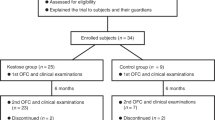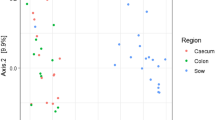Abstract
Background/objectives:
At present, there is debate about the gastrointestinal effects of A1-type beta-casein protein in cows’ milk compared with the progenitor A2 type. In vitro and animal studies suggest that digestion of A1 but not A2 beta-casein affects gastrointestinal motility and inflammation through the release of beta-casomorphin-7. We aimed to evaluate differences in gastrointestinal effects in a human adult population between milk containing A1 versus A2 beta-casein.
Subjects/methods:
Forty-one females and males were recruited into this double-blinded, randomised 8-week cross-over study. Participants underwent a 2-week dairy washout (rice milk replaced dairy), followed by 2 weeks of milk (750 ml/day) that contained beta-casein of either A1 or A2 type before undergoing a second washout followed by a final 2 weeks of the alternative A1 or A2 type milk.
Results:
The A1 beta-casein milk led to significantly higher stool consistency values (Bristol Stool Scale) compared with the A2 beta-casein milk. There was also a significant positive association between abdominal pain and stool consistency on the A1 diet (r=0.520, P=0.001), but not the A2 diet (r=−0.13, P=0.43). The difference between these two correlations (0.52 versus −0.13) was highly significant (P<0.001). Furthermore, some individuals may be susceptible to A1 beta-casein, as evidenced by higher faecal calprotectin values and associated intolerance measures.
Conclusions:
These preliminary results suggest differences in gastrointestinal responses in some adult humans consuming milk containing beta-casein of either the A1 or the A2 beta-casein type, but require confirmation in a larger study of participants with perceived intolerance to ordinary A1 beta-casein-containing milk.
This is a preview of subscription content, access via your institution
Access options
Subscribe to this journal
Receive 12 print issues and online access
$259.00 per year
only $21.58 per issue
Buy this article
- Purchase on SpringerLink
- Instant access to full article PDF
Prices may be subject to local taxes which are calculated during checkout

Similar content being viewed by others
References
Davies DT, Law AJR . The content and composition of creamery milks in south-west Scotland. J Dairy Res 1980; 47: 80–90.
Walstra P, Jenness R . Proteins. In: Dairy Chemistry and Physics. John Wiley & Sons: New York, 1984, pp 98–122.
Ng-Kwai-Hang KF, Grosclaude F . Genetic polymorphism of milk proteins. In: Fox PF, McSweeney PLH (eds). Advanced Dairy Chemistry: Volume 1: Proteins, Parts A & B. Kluwer Academic/Plenum Publishers: New York, 2002, pp 739–816.
Scientific Report of EFSA prepared by a DATEX Working Group on the potential health impact of β-casomorphins and related peptides. EFSA Sci Rep 2009; 231: 1–107.
Boutrou R, Gaudichon C, Dupont D, Jardin J, Airinei G, Marsset-Baglieri A et al. Sequential release of milk protein-derived bioactive peptides in the jejunum in healthy humans. Am J Clin Nutr 2013; 97: 1314–1323.
De Noni I, Cattaneo S . Occurrence of beta-casomorphins 5 and 7 in commercial dairy products and in their digests following in vitro simulated gastro-intestinal digestion. Food Chem 2010; 119: 560–566.
De Noni I . Release of b-casomorphins 5 and 7 during simulated gastro-intestinal digestion of bovine b-casein variants and milk-based infant formulas. Food Chem 2008; 110: 897–903.
Jinsmaa Y, Yoshikawa M . Enzymatic release of neocasomorphin and beta-casomorphin from bovine beta-casein. Peptides 1999; 20: 957–962.
Cielinkska A, Kostyra EB, Kostyra H, Olenski K, Fiedorowicz E, Kaminski SA . Milk from cows of different beta-casein genotypes as a source of beta-casomorphin-7. Int J Food Sci Nutr 2012; 63: 426–20.
Schmelzer CE, Schops R, Reynell L, Ulbrich-Hofmann R, Neubert RH, Raith K . Peptic digestion of beta-casein. Time course and fate of possible bioactive peptides. J Chromatogr A 2007; 1166: 108–115.
Brantl V, Teschemacher H, Blasig J, Henschen A, Lottspeich F . Opioid activities of beta-casomorphins. Life Sci 1981; 28: 1903–1909.
Pleuvry BJ . Opioid receptors and their ligands: natural and unnatural. Br J Anaesth 1991; 66: 370–380.
Haq MR, Kapila R, Sharma R, Saliganti V, Kapila S . Comparative evaluation of cow β-casein variants (A1/A2) consumption on Th2-mediated inflammatory response in mouse gut. Eur J Nutr 2013; 53: 1039–1049.
Barnett MPG, McNabb WC, Roy NC, Woodford K, Clarke AJ . Dietary A1 β-casein affects gastrointestinal transit time, dipeptidyl peptidase-4 activity, and inflammatory status relative to A2 β-casein in Wistar rats. Int J Food Sci Nutr 2014; e-pub ahead of print 20 March 2014; doi:10.3109/09637486.2014.898260.
Kreil G, Umbach M, Brantl V, Teschemacher H . Studies on the enzymatic degradation of beta-casomorphins. Life Sci 1983; 33 (Suppl 1), 137–140.
Drucker DJ . The biology of incretin hormones. Cell Metab 2006; 3: 153–165.
Holst JJ, Gromada J . Role of incretin hormones in the regulation of insulin secretion in diabetic and nondiabetic humans. Am J Physiol Endocrinol Metab 2004; 287: E199–E206.
Imeryuz N, Yegen BC, Bozkurt A, Coskun T, Villanueva-Penacarrillo ML, Ulusoy NB . Glucagon-like peptide-1 inhibits gastric emptying via vagal afferent-mediated central mechanisms. Am J Physiol 1997; 273: G920–G927.
Schirra J, Sturm K, Leicht P, Arnold R, Goke B, Katschinski M . Exendin(9–39)amide is an antagonist of glucagon-like peptide-1(7–36)amide in humans. J Clin Invest 1998; 101: 1421–1430.
Schirra J, Nicolaus M, Roggel R, Katschinski M, Storr M, Woerle HJ et al. Endogenous glucagon-like peptide 1 controls endocrine pancreatic secretion and antro-pyloro-duodenal motility in humans. Gut 2006; 55: 243–251.
Lupp C, Robertson ML, Wickham ME, Sekirov I, Champion OL, Gaynor EC et al. Host-mediated inflammation disrupts the intestinal microbiota and promotes the overgrowth of Enterobacteriaceae. Cell Host Microbe 2007; 2: 119–129.
Elitsur Y, Luk GD . Beta-casomorphin (BCM) and human colonic lamina propria lymphocyte proliferation. Clin Exp Immunol 1991; 85: 493–497.
Kayser H, Meisel H . Stimulation of human peripheral blood lymphocytes by bioactive peptides derived from bovine milk proteins. FEBS Lett 1996; 383: 18–20.
Zoghbi S, Trompette A, Claustre J, El Homsi M, Garzon J, Jourdan G et al. beta-Casomorphin-7 regulates the secretion and expression of gastrointestinal mucins through a mu-opioid pathway. Am J Physiol Gastrointest Liver Physiol 2006; 290: G1105–G1113.
Trompette A, Claustre J, Caillon F, Jourdan G, Chayvialle JA, Plaisancie P . Milk bioactive peptides and beta-casomorphins induce mucus release in rat jejunum. J Nutr 2003; 133: 3499–3503.
Svedberg J, de Haas J, Leimenstoll G, Paul F, Teschemacher H . Demonstration of beta-casomorphin immunoreactive materials in in vitro digests of bovine milk and in small intestine contents after bovine milk ingestion in adult humans. Peptides 1985; 6: 825–830.
Kost NV, Sokolov OY, Kurasova OB, Dmitriev AD, Tarakanova JN, Gabaeva MV et al. Beta-casomorphins-7 in infants on different type of feeding and different levels of psychomotor development. Peptides 2009; 30: 1854–1860.
Wasilewska J, Sienkiewicz-Szlapka E, Kuzbida E, Jarmolowska B, Kaczmarski M, Kostyra E . The exogenous opioid peptides and DPPIV serum activity in infants with apnoea expressed as apparent life threatening events (ALTE). Neuropeptides 2011; 45: 189–195.
Booth M . Assessment of physical activity: an international perspective. Res Q Exerc Sport 2000; 71: S114–S120.
Gearry R, Barclay M, Florkowski C, George P, Walmsley T . Faecal calprotectin: the case for a novel non-invasive way of assessing intestinal inflammation. N Z Med J 2005; 118: U1444.
Däbritz J, Musci J, Foell D . Diagnostic utility of faecal biomarkers in patients with irritable bowel syndrome. World J Gastroenterol 2014; 20: 363–375.
O'Donnell LJ, Virjee J, Heaton KW . Detection of pseudodiarrhoea by simple clinical assessment of intestinal transit rate. BMJ 1990; 300: 439–440.
Degen LP, Phillips SF . How well does stool form reflect colonic transit? Gut 1996; 39: 109–113.
Lewis SJ, Heaton KW . Stool form scale as a useful guide to intestinal transit time. Scand J Gastroenterol 1997; 32: 920–924.
Davies GJ, Crowder M, Reid B, Dickerson JW . Bowel function measurements of individuals with different eating patterns. Gut 1986; 27: 164–169.
Mourad FH, Barada KA, Bou Rached NA, Khoury CI, Saade NE, Nassar CF . Inhibitory effect of experimental colitis on fluid absorption in rat jejunum: role of the enteric nervous system, VIP, and nitric oxide. Am J Physiol Gastrointest Liver Physiol 2006; 290: G262–G268.
Sundaram U, Wisel S, Coon S . Neutral Na-amino acid cotransport is differentially regulated by glucocorticoids in the normal and chronically inflamed rabbit small intestine. Am J Physiol Gastrointest Liver Physiol 2007; 292: G467–G474.
Jussila J, Launiala K, Gorbatow O . Lactase deficiency and a lactose-free diet in patients with ‘unspecific abdominal complaints’. Acta Med Scand 1969; 186: 217–222.
Carroccio A, Montalto G, Cavera G, Notarbatolo A . Lactose intolerance and self-reported milk intolerance: relationship with lactose maldigestion and nutrient intake. Lactase Deficiency Study Group. J Am Coll Nutr 1998; 17: 631–636.
Johnson AO, Semenya JG, Buchowski MS, Enwonwu CO, Scrimshaw NS . Correlation of lactose maldigestion, lactose intolerance, and milk intolerance. Am J Clin Nutr 1993; 57: 399–401.
Acknowledgements
This study was supported by a grant from A2 Dairy Products Australia, who also supplied the milk. A2 Dairy Products Australia had no role in the data analysis of this study.
Author contributions
All authors contributed to the research design (project conception, development of overall research plan and study oversight). SH and SP conducted the research (hands-on conduct of the experiments and data collection). KW analysed the data and performed statistical analyses. SK, KW, SH and SP wrote the paper. All authors had primary responsibility for the final content.
Author information
Authors and Affiliations
Corresponding author
Ethics declarations
Competing interests
Dr Sonja Kukuljan is a salaried employee of A2 Dairy Products Australia. Professor Keith Woodford consults to A2 Corporation as an independent scientific adviser. The remaining authors declare no conflict of interest.
Rights and permissions
About this article
Cite this article
Ho, S., Woodford, K., Kukuljan, S. et al. Comparative effects of A1 versus A2 beta-casein on gastrointestinal measures: a blinded randomised cross-over pilot study. Eur J Clin Nutr 68, 994–1000 (2014). https://doi.org/10.1038/ejcn.2014.127
Received:
Revised:
Accepted:
Published:
Issue Date:
DOI: https://doi.org/10.1038/ejcn.2014.127
This article is cited by
-
A2 milk consumption and its health benefits: an update
Food Science and Biotechnology (2024)
-
Effects of A1 and A2 variants of β-casein on human health—is β-casomorphin-7 really a harmful peptide in cow milk?
Nutrire (2022)
-
Circulatory amino acid responses to milk consumption in dairy and lactose intolerant individuals
European Journal of Clinical Nutrition (2022)
-
Demographic pattern of A1/A2 beta casein variants indicates conservation of A2 type haplotype across native cattle breeds (Bos indicus) of India
3 Biotech (2022)
-
The Moo’D Study: protocol for a randomised controlled trial of A2 beta-casein only versus conventional dairy products in women with low mood
Trials (2021)



